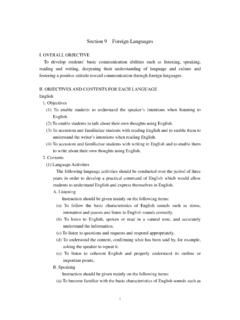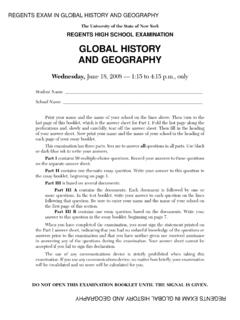Transcription of Guidelines for Building International Joint Diploma ...
1 Guidelines for Building International Joint Diploma Programs Including Double and Joint Degree Programs November 14, 2014 Central Council for education Working Group on the Internationalization of Universities, Japan Contents Chapter 1 Overview 1 1. Objectives 1 2. Basic Principles 1 3. Significance 2 4. Definitions 4 Chapter 2 Outline of the Scheme 6 1.
2 Basic Principles 6 2. Mechanism of the Scheme 7 Chapter 3 Points of Attention for the Establishment of JD Programs 21 1. Basic Matters 21 2. Basic Design of JD Programs 21 Degree level, academic field covered and name; Diploma ; Partner university (ies) in foreign country; Inter-university agreement; Selection, screening, etc. of entrants to JD program; Student registry and record; Size 3. Curriculum design, Examination for conferral of degree, etc.
3 24 Human resources to be developed; Language; Form of education ; Classes with various types of media in a highly advanced manner; Requirements for graduation and completion; Earning of credits; Courses jointly designed; Grading; Thesis; Degree examination for graduation; Supervision system; Academic staffs; School site, buildings, facilities, equipment, etc.; mobility of students; Study environment 4. Other 29 Tuition, scholarships, etc.; Safety net; Evaluation and quality assurance; Recognition and evaluation by society Chapter 4 Joint Educational Programs, including Double Degree 31 1.
4 Basic Principles 31 2. Points of Attention for Operation of DD Programs 32 (1) Issues to be examined at the outset 32 (2) Agreements on Joint implementation 32 (3) Organization of curricula 33 (4) Degree examination for graduation 33 (5) Evaluation of educational and research activities 34 (6) Student support 34 (7)
5 Information publication 35 *The English text is for reference and the text in the Japanese language shall be the authentic text. 1 Chapter 1 Overview With the trend of globalization in various fields, cross-border mobility of students and academic staff in higher education has been growing at an accelerated pace, and universities are beginning to work actively on various Joint educational programs. Japan, too, must improve its International compatibility of educational systems to meet global ones and ultimately enhance its International competitiveness from the standpoints of developing education , research, and human resources that can proactively contribute to the peace and prosperity of the world.
6 To this end, Japan has, on the initiative of the Central Council for education , discussed the necessity of an attractive mechanism enabling Japanese universities to create Joint programs and confer academic degrees jointly with universities in foreign countries with appropriate quality assurance of the degrees conferred and programs offered, so that Japanese universities can successfully host competent overseas students and more capable, motivated young Japanese students can study abroad. Based on this understanding, a new scheme was put into effect under the Japanese legal system to allow Japanese universities (including junior colleges: the same shall apply hereinafter) to organize academic programs with foreign universities jointly (hereinafter referred to as " International Cooperative Curricula (ICC) Scheme") to confer Joint degrees (hereinafter referred to as "JD").
7 The Guidelines have been formulated to be used by universities in Japan as a reference when they build their International Joint Diploma programs, including JD programs. 1. Objectives The Guidelines have been formulated in light of "University education and Global Human Resource Development for the Future" (third proposal) published on May 28, 2013, by the education Rebuilding Implementation Council. The objectives are, in corresponding to the globalization of university education , to facilitate organized and continuous cooperation, including double degree (hereinafter referred to as "DD") and JD between universities in Japan and those in foreign countries, ensure the quality of degrees conferred and programs offered under these programs, and ultimately ensure and improve the quality of higher education in Japan and abroad.
8 The Guidelines have no legally binding effect but present points of attention which universities should refer to when designing actual JD and other programs under the scheme, and also serve as basic materials when the viewpoints of program development are examined by government. Universities and other parties concerned are expected to take the Guidelines into full consideration. 2. Basic Principles There is no clear and detailed International agreement on how universities in different countries should develop cooperative programs, and this fact partly causes difficulties for 2 universities to advance discussion for program design. On the other hand, universities in a number of countries and regions are also taking steps, including the development of DD, JD and other cooperative programs with foreign universities while boosting student mobility .
9 In such circumstances, the development of JD, DD and other cooperative programs, as well as organized and continuous educational partnerships, between universities in Japan and foreign countries will enable the former to offer wider educational opportunities, give Japanese students opportunities to experience different cultures, and contribute to closer regional cooperation. Such educational cooperation, particularly with Asian higher education institutions, will not just vitalize exchanges in higher education based on geographical advantages, but also enable us to build mutually-beneficial relations through Joint educational programs and greatly contribute to regional peace and prosperity.
10 JD particularly matches the period background of this global era because it enables universities to take advantage of the educational resources of other universities and provide students with advanced programs that a single university cannot offer, and to take a step forward from the stage of singly conferring academic degrees to the stage of jointly conferring academic degrees as an "integrated cross-border entity. Universities are expected to actively commit themselves to such an organized and continuous International educational cooperation while continuing to respect their own traditions and principles as well as developing its uniqueness. Universities are expected to clearly be aware of International reputation and recognition, to ensure the quality of education and determine which of JD or DD to introduce.















